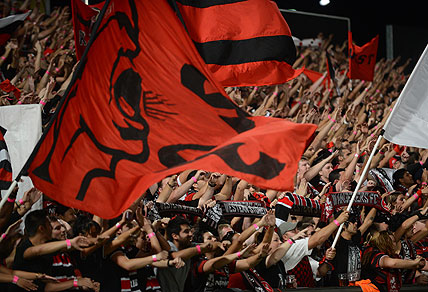Every season, football fans in Australia fervently argue over the direction of the A-League, and this year fans are longing for expansion once again.
After three big opening rounds to the season, Football Federation Australia has confirmed attendance, free-to-air and Foxtel TV ratings have all increasing strongly. This news is music to the ears of the FFA, especially during the tense, tricky and incredibly vital television rights negotiations.
With Foxtel and multiple free-to-air stations interested, Australian football looks set to increase its commercial revenues. However, when the money is coming in, football fans expect spending too, and in 2016-17, expansion is going to be on top of their wishlist.
Contrary to what many football pessimists might say, the FFA have had more success in expansion than failure.
Wellington Phoenix is sustainable across the ditch and Melbourne Heart – now City – ignited a unique culture of cross-city sporting rivalry in Australia. We’ll get onto the Western Sydney Wanderers in a second.
Of course, there are two black blots on their record too. Gold Coast United started off with a bang before owner Clive Palmer’s erratic behaviour drove almost all fans away. Then there was North Queensland Fury, the Townsville-based club that began in a more modest fashion, but fell with its owner Don Matheson’s financial woes.
These four clubs taught the A-League one very crucial lesson – expansion must be strong or not happen at all. They took this approach for Gold Coast United’s empty place, where they built the Western Sydney Wanderers around an existing football culture in a few short months.
The result was simply incredible.
Within 12 months, the Wanderers averaged a crowd of over 14,500 people, made the A-League grand final, and astonishingly, won the Asian Champions League, qualifying for the FIFA World Club Cup. Whether you like Western Sydney or not, all fans were unanimous in the belief that this was an excellent case for A-League expansion.

Fast-forward to 2016 and everyone – fans, clubs, Head of the A-League Greg O’Rourke and notably, Ange Postecoglou – seems to be on the same page. The Socceroos coach spells out a clear mandate in his new book Changing the Game, quoted as saying “consolidating at a time of growth seems counter-intuitive to me.”
It’s a strong sentiment the football community is sharing right now in Australia.
Currently, football fans butt heads over which corner of Australia is the next A-League destination. While the FFA calculates market size and population ‘corridors’ in Brisbane and Sydney, fans long for more regional options like Wollongong, Canberra, Geelong and Tasmania. Both sides make valid points.
In short, the major city corridors boast large groups of population, but with a limited sense of collectivism and regional pride, making the marketing challenge much more difficult. The touted regional cities are easier to unite, however, they have a considerably smaller population base to attract – usually three to five times smaller than the major city options.
So how do we work out which option is the most viable?
For me, A-League expansion shouldn’t be rushed for next season, but we are well overdue for a second division in Australia – let’s call it The A2-League.
This is the best place to judge the viability of A-League clubs – financially, football-wise and on their match day attendance. From here, when the club passes all the trials and tribulations of national football on a smaller, less risky scale, they should be promoted into the top division. However, its benefits can span much further than just more entertainment and more teams in the league.
The A2-League can be highly important to developing our young footballers into superstars. Nothing develops young talent better than playing in the men’s division.
At 18-years-old, legendary Socceroos Mark Viduka, Harry Kewell, Tim Cahill and Mark Schwarzer played with and faced men in their respective leagues, not other youths. That is the making of a young footballer. Like the American second division United Soccer League, the National Youth League should merge into the A2-League.
The A2-League will also help stem the flow of Australian players to the football wildernesses of South East Asia and beyond. Instead, it would provide a local platform for players like Diogo Ferreira, Antony Golec, Hagi Gligor, Rocky Visconte and more to reaffirm their value and get back in the A-League.
The best talent currently in the National Premier Leagues would have the chance to test themselves against these players that were once in the top division. Better yet, it offers less affluent teams like Central Coast Mariners the chance to scout better players more easily.
It’s a win-win-win situation for all.
Additionally, it ensures that the best bids win entry to the A-League, not the loudest. This way, we can scale the real performance position of whether Brisbane’s Ipswich corridor is more powerful than a Wollongong bid, which significantly mitigates risk. Under-complete bids would be in a better spotlight for financial investors to consider too.
Finally, the league could also offer smaller regional centres the chance to compete, even if they’re not interested in promotion. The A2-League could incorporate teams from Darwin, Bunbury, Bendigo, Ballarat, the Blue Mountains, Cairns, Sunshine Coast and smaller centres, making football a truly national game.
Expansion should not be a game of Russian roulette and the only thing that can assure this is a second division for football in Australia.






























































































